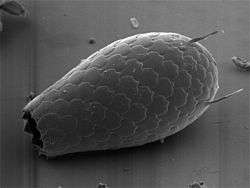Euglyphida
| Euglyphids | |
|---|---|
 | |
| Euglypha sp. | |
| Scientific classification | |
| Domain: | Eukaryota |
| (unranked): | SAR |
| (unranked): | Rhizaria |
| Phylum: | Cercozoa |
| Subphylum: | Filosa |
| Superclass: | Monadofilosa |
| Class: | Imbricatea |
| Order: | Euglyphida Copeland, 1956 |
| Families | |
|
Cyphoderiidae | |
The euglyphids are a prominent group of filose amoebae that produce shells or tests from siliceous scales, plates, and sometimes spines. These elements are created within the cell and then assembled on its surface in a more or less regular arrangement, giving the test a textured appearance. There is a single opening for the long slender pseudopods, which capture food and pull the cell across the substrate.
Euglyphids are common in soils, marshes, and other organic-rich environments, feeding on tiny organisms such as bacteria. The test is generally 30-100 μm in length, although the cell only occupies part of this space. During reproduction a second shell is formed opposite the opening, so both daughter cells remain protected. Different genera and species are distinguished primarily by the form of the test. Euglypha and Trinema are the most common.
The euglyphids are traditionally grouped with other amoebae. However, genetic studies instead place them with various amoeboid and flagellate groups, forming an assemblage called the Cercozoa. Their closest relatives are the thaumatomonads, flagellates that form similar siliceous tests.
| Wikispecies has information related to: Euglyphida |